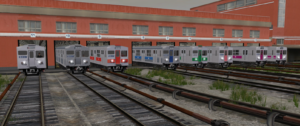
From left to right: unpainted aluminium trains, unpainted stainless-steel trains, Midosuji Line livery, Yotsubashi Line livery, Chuo Line livery, Sennichimae Line livery and the Tanimachi Line New 30 Series.
DOWNLOAD (update planned)
All the necessary dependencies are either included in this package or are avaible on the DLS.
The 30 series was introduced in 1967 to replace or displace all the pre-war and immediately post-war rolling stock on most of the third-rail powered lines (anything from the 100 series of 1933 up to the 1100 series of 1958) and to provide new trains for lines due to open (the Tanimachi Line and most of the Chuo Line. The Sennichimae Line, altough opened in 1969 was to be served by displaced rolling stock).
One of the main deadlines was the Expo’70, wich was to be located to the north of the terminus of the Midosuji Line (the line was in fact extended by the Kita-Osaka-Kyuko railway).
With such a great event coming, there were ongoing discussions in the Osaka Municipal Transportation Bureau about how to prepare in the best way: start the construction of new lines; keep old stock; purchase new stock altogheter; should the new stock use the standards of the old ones…
The decision was left to Tsuruyoshi Imaoka, the then-chairman, wich said: “We ought to build 240 vehicles with 4 doors and 18m bodies, equipped with the lastest WS-ATC system (wich would be the one used in the TRTA Hibiya and Tozai Lines) and we should focus on Line No.1 (Midosuji Line), as it will be the main way to get to the Expo.”
The new rolling stock would have to be as cheap and as fast to be built as possible, altough with a few improvements compared to the older stock, such an 18m body with 4 doors compared to the 17 with 3 doors of the old stock and a cardan drive system in lieu of the old “nose-suspended” motors, so to contain costs, a standardized model was designed.
In 1967 two trains appeard: the 7000 series with an aluminum body and the 8000 series with a stainless steel body. Altough using different materials, the two were substantially identical, with the same squared, simplicistic body (they also shared motors, bogeys, traction equipment, interiors, driving cabs, headlights…).
Tests were highly successful and more sets of both type of trains were ordered: these would become the 30 series. By the time of the Expo, 224 vehicles were in service.
After the Expo, the 30 series started recieving bodyside stripes indicating the line color, to avoid passengers mistaking trains: red for the Midosuji Line, green for the Chuo Line, blue for the Yotsubashi Line and purple for the Tanimachi Line.
In 1973, new vehicles were put in service for the Tanimachi Line: the New 30 series.
These were a largely improved version of the 30 series, they had more rounded roofs, more comfortable interiors and driving cabs and were predisposed for air conditioning.
The old 30 series on the other hand, by the mid 1980s started to show their rushed design.
The lack of air conditioning was one of the most notable problems of this stock, especially on the Midosuji Line, the crowdedmost line of the Subway.
A plan to retrofit the stock with AC was shelved almost immediately due to the extremely high costs and complexity of having to completely rebuild the roofs of the carriages.
The obsolescence of the 30 series became particularily evident compared to the newer 10 series (1979) and 20 series (1984), thus by 1990 new rolling stock was introduced: the New 20 series.
The withdrawal process began in the mid-1980s and the first to be retired were the ones of the Midosuji Line in 1993, followed by the Chuo and Yotsubashi Line trains (both in 1995).
Some Midosuji Line trains were also repainted in pink and transferred to the Sennichimae Line, where they ran briefly between 1991 an 1995.
While alluminium trains were all retired by 1995, the more durable stainless steel trains were transferred to the Tanimachi Line, where they ran along air-conditioned retrofitted 30 series trains until 2013 (almost 20 years later compared to the other 30s), when they were replaced by the 30000 series.
Two vehicles (both driving cars) were preserved: one stainless steel car from the Yotsubashi Line (No.3062, wich originally was No.7001) and one alluminuim car from the Chuo Line (No.3042, wich originally was No.3008) wich was later “re-painted” to the original 1970 aspect.
Both are in working order, in fact, No.3062 ran a short (couple of meters) distance during the 2013 Osaka Subway festival.
The consists avaible are:
– Unpainted (alluminium), 8-car set.
– Unpainted (stainless steel), 8-car set.
– Midosuji Line (alluminum), 9-car set.
– Chuo Line (alluminum), 6-car set.
– Yotsubashi Line (stainless steel), 5-car set.
– Yotsubashi Line (stainless steel with wide front doors), 5-ar set.
– Yotsubashi Line 2nd liviery (stainless steel), 5-car set.
– Sennichimae Line, 4-car set.
– Tanimachi Line (New 30 series), 6-car set.
– Tanimachi Line 2nd liviery (New 30 series), 6-car set.
